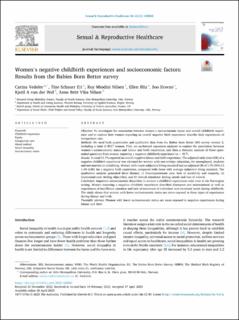| dc.contributor.author | Vedeler, Carina | |
| dc.contributor.author | Eri, Tine Schauer | |
| dc.contributor.author | Nilsen, Roy Miodini | |
| dc.contributor.author | Blix, Ellen | |
| dc.contributor.author | Downe, Soo | |
| dc.contributor.author | van der Wel, Kjetil A. | |
| dc.contributor.author | Nilsen, Anne Britt Vika | |
| dc.date.accessioned | 2023-06-09T11:58:58Z | |
| dc.date.available | 2023-06-09T11:58:58Z | |
| dc.date.created | 2023-05-04T15:45:05Z | |
| dc.date.issued | 2023 | |
| dc.identifier.issn | 1877-5756 | |
| dc.identifier.uri | https://hdl.handle.net/11250/3070758 | |
| dc.description.abstract | Objective
To investigate the association between women's socioeconomic status and overall childbirth experience and to explore how women reporting an overall negative birth experience describe their experiences of intrapartum care.
Methods
We used both quantitative and qualitative data from the Babies Born Better (B3) survey version 2, including a total of 8317 women. First, we performed regression analyses to explore the association between women’s socioeconomic status and labour and birth experience, and then a thematic analysis of three open-ended questions from women reporting a negative childbirth experience (n = 917).
Results
In total 11.7% reported an overall negative labour and birth experience. The adjusted odds ratio (OR) of a negative childbirth experience was elevated for women with non-tertiary education, for unemployed, students and not married or cohabiting. Women with lower subjective living standard had an adjusted OR of 1.70 (95% CI 1.44–2.00) for a negative birth experience, compared with those with average subjective living standard. The qualitative analysis generated three themes: 1) Uncompassionate care: lack of sensitivity and empathy, 2) Impersonal care: feeling objectified, and 3) Critical situations: feeling unsafe and loss of control.
Conclusion
Important socioeconomic disparities in women’s childbirth experiences exist even in the Norwegian setting. Women reporting a negative childbirth experience described disrespect and mistreatment as well as experiences of insufficient attention and lack of awareness of individual and emotional needs during childbirth. The study shows that women with lower socioeconomic status are more exposed to these types of experiences during labour and birth. | en_US |
| dc.language.iso | eng | en_US |
| dc.publisher | Elsevier | en_US |
| dc.rights | Navngivelse 4.0 Internasjonal | * |
| dc.rights.uri | http://creativecommons.org/licenses/by/4.0/deed.no | * |
| dc.title | Women’s negative childbirth experiences and socioeconomic factors: Results from the Babies Born Better survey | en_US |
| dc.type | Peer reviewed | en_US |
| dc.type | Journal article | en_US |
| dc.description.version | publishedVersion | en_US |
| dc.rights.holder | © 2023 The Author(s) | en_US |
| dc.source.volume | 36 | en_US |
| dc.source.journal | Sexual & Reproductive HealthCare | en_US |
| dc.identifier.doi | 10.1016/j.srhc.2023.100850 | |
| dc.identifier.cristin | 2145620 | |
| dc.source.articlenumber | 100850 | en_US |
| cristin.ispublished | true | |
| cristin.fulltext | original | |
| cristin.qualitycode | 1 | |

